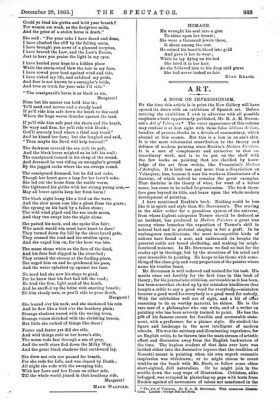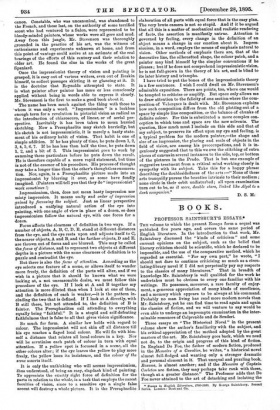ART.
A BOOK ON IMPRESSIONISM.
BY the time this article is in print the New Gallery will have opened its doors with an exhibition of Spanish art. Before noticing the exhibition I wish to advertise with all possible emphasis a book opportunely published, Mr. R. A. M. Steven- son's .Art of Velazquez.* The outer appearance of this volume may confuse it at first sight with those false i:ditions de luxe, bundles of process-blocks in a drizzle of commentary, which abound at this season. But this is a lion in an ass's skin. It is the most substantial contribution to the theory and defence of modern painting since Ruskin's Modern Painters. It is a sort of complement and corrective to that ex- traordinary work, and is to be put on the shelf with the few books on painting that are clarified by know- ledge of the art from within, like Fromentin's Maltrts d'Autrefois. It is both less and more than a disquisition on Velazquez; less, because it uses his works as illustrations of a doctrine, of which indeed he remains the great exemplar. That doctrine is the theory of what, for want of a better name, has come to be called Impressionism. The book there- fore goes beyond its title, and bears upon the whole modern development of painting.
I have mentioned Ruskin's book. Nothing could be less like it in spirit and style than Mr. Stevenson's. The craving in the older writer for a grandiose system of the universe, from whose highest categories Turner should be deduced as an incident, has produced in Modern Painters a great tree among whose branches the exposition of Turner's skill in natural fact and in pictorial shaping is but a graft. In its umbrageous ramifications, the most incompatible birds of culture have found a nest, and underneath its boughs the queerest cattle are found sheltering, and making its neigh- bourhood noisome. In Mr. Stevenson we find no bait for the reader apt in theology, but by the structure of his mind and eyes insensible to painting. He keeps to his theme with some- thing of the close grip and wary proportion of the painter whose name his treatise bears.
Mr. Stevenson is well endowed and trained for his task. His merits come out forcibly for the first time in this book of theory ; for his journalistic criticism, serviceable as it has been, has been somewhat choked up by the mistaken kindliness that tempts a critic to say a good word for everybody,—mistaken because a good word for everybody is a good word for nobody. With the celebrities well out of sight, and a bit of °liar reasoning to do on worthy material, he shines. He is the rare case of a philosopher who can write, and of a writer on painting who has been severely trained to paint. He has the gift of his famous cousin for forcible and memorable state- ment, with a preference for a plainer style. He studied the figure and landscape in the most intelligent of modern schools. His was the salutary and illuminating experience, for an English critic, to be thrown into the main stream of artistic effort and discussion away from the English backwaters of the time. The hapless student of that date over here was invited either into the decorative impasse that the tradition of Rossetti meant in painting when his own superb romantie inspiration was withdrawn; or he might choose to count winkles on the beach with Mr. Brett, or follow some other short-sighted, dull naturalism. Or he might join in the scuttle down the easy ways of illustration. Criticism, alike befogged, was occupied in plastering-up gaps with texts from Raskin against all newcomers of talent not mentioned in the • The Art of Velazquez. By B. A. K. Stevenson. With numerous Madre" t:ons. London: George Bell and SOWS.
canon. Constable, who was uncanonical, was abandoned to the French, and these last, on the authority of some terrified scout who had ventured to a Salon, were represented to be bloody-minded painters, whose works were all gore and mud. Away from this jangle, Mr. Stevenson was thoroughly grounded in the practice of his art, was the witness of enthusiasms and experiments unknown at home, and from this point of vantage could arrive at an estimate of the real bearings of the efforts of this century and their relation to older art. He found the clue in the works of the great Spaniard.
Once the impressionist theory of vision and painting is grasped, it is easy out of various writers, even out of Ruskin himself, to collect passages skirting it or glancing at it. It is the doctrine that Reynolds attempted to state. It is what painter after painter has more or less consciously applied without being in words able to express it. clearly. Mr. Stevenson is the first to make a good book about it.
The name has been much against the thing with those to 'whom it was only a word. " Impressionism " is a luckless enough term for a revolution in pictorial vision as radical as the introduction of chiaroscuro, of linear, or of aerial per- spective. Inevitably it has been taken to mean hurried sketching. Now a Preraphaelite may sketch hurriedly, but his sketch is not impressionistic, it is merely a hasty state- ment of his ordinary habit of vision. That habit is one of simple addition. If he has plenty of time, he puts down 1, 2, 3, 4, 5, 6, 7. If he has less than half the time, he puts down 1, 2, and a bit of 3. This impressionist goes to work by summing these particulars before he puts down the result. He is therefore capable of a more rapid statement, but time is not of the essence of his procedure. His process of thought may take a longer time than the other's thoughtless enumera- tion. Nor, again, is a Preraphaelite picture made into an impressionist by blurring it over, as some have fondly imagined. (Painters will tell you that they do" impressionist" work sometimes !)
Impressionism, then, does not mean hasty impression nor misty impression. It means unity and order of impression gained by focussing the subject. Just as linear perspective introduced a unifying natural action of the eye into painting, with one angle of view in place of a dozen, so does impressionism follow the natural eye, with one focus for a dozen.
Focus affects the clearness of definition in two ways. If a number of objects, A, B, C, D, E, stand at different distances from the eye, and the eye rests upon and adjusts itself to C, the nearer objects, A and B, and the farther objects, D and E, are thrown out of focus and are blurred. This may be called the focus of distance, and to represent two objects at different depths in a picture with the same clearness of definition is to puzzle and contradict the eye.
Bat there is also the focus of attention. According as the eye selects one feature of a scene, or allows itself to wander more freely, the definition of the parts will alter, and if we wish in a picture that it should be known what we were looking at, a not unreasonable desire, we must follow this procedure of the eye. If I look at A and B together my attention is more diluted than when I look at one of them, and the definition of each is weaker,—it is the pattern in- cluding the two that is defined. If I look at A directly, with B still there, but not attended to, the definition of B is fainter. The Preraphaelites call attending to everything equally being "faithful." It is a stupid and self-defeating faithfulness that is false to all that gives vision significance.
So much for form. A similar law holds with regard to colour. The impressionist will not skin off all distance till his eye reaches a flayed local colour. He will fix with him- self a distance that relates all local colours in a key. Nor will he scrutinise each patch of colour in turn with equal attention. If a yellow spot is focussed in a scene, all the other colours alter; if the eye leaves the yellow to play more freely, the yellow loses its insistence, and the colour of the scene asserts itself.
It is only the unthinking who will accuse impressionism, thus understood, of being an easy, slapdash kind of painting. To appreciate the exactly right force of definition for the parts in relation to the whole, is a task that employs the rarest faculties of vision, since to a sensitive eye a single false accent will destroy a whole picture. It is the Preraphaelite
elaboration of all parts with equal force that is the easy plan. The very brute camera is not so stupid. And if it be argued that all this is a matter of mechanical and realistic rendering of facts, the assertion is manifestly untrue. Attention is governed by feeling, every change in the definition of an object means a change in our emotion about it. Impres- sionism, in a word, employs the means of emphasis natural to vision. Other methods of emphasis there are, that of the decorative line, the silhouetted shape, the colour patch, and a painter may bind himself by the simpler conventions if he pleases ; but if he does not comprehend impressionistic vision, he is not full-grown in the theory of his art, and is blind to its later history and triumphs.
I have tried to put the bones of the impressionistic theory in a few sentences. I wish I could dwell on Mr. Stevenson's admirable exposition. There are points, too, where one would be tempted to criticise or amplify. Bat space only allows me to draw attention to the felicity of one section where the com- position of Velazquez is dealt with. Mr. Stevenson explains how such composition differs from the old plotting-out of a space by simple line composition, or the balance of chunks of definite colour. For this is substituted a more complex con- ception in which tone and space are the new solvents. The question, How much must I include on this side and that of my subject, to preserve its effect upon my eye and feeling, is a typical problem for the modern painter,—the shape and size of an impression, the placing and scale of objects in the field of vision, are among his preoccupations, and it is in- geniously suggested that to this we owe the stitching of extra pieces of canvas in several instances to the side, top, or bottom of the pictures in the Prado. That is but one example of suggestive treatment from a critical mind working closely in sympathy with its subject. Take this for a happy phrase describing the doublesidedness of the arts :—" None of these arts tranquilly pursue the beauties intrinsic to their medium ; none circle in their orbit undisturbed ; all upon examination turn out to be, as it were, double stars, linked like Algol to a dark companion." D. S. 11:



































 Previous page
Previous page